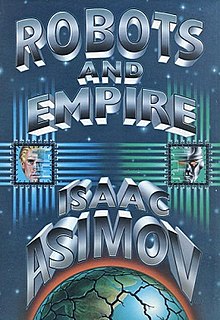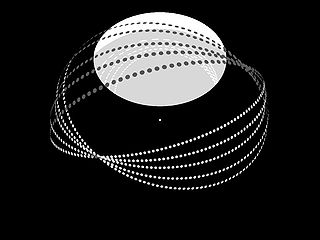
Gregory Benford is an American science fiction author and astrophysicist who is Professor Emeritus at the Department of Physics and Astronomy at the University of California, Irvine. He is a contributing editor of Reason magazine.

Gregory Dale Bear is an American writer and illustrator best known for science fiction. His work has covered themes of galactic conflict, artificial universes, consciousness and cultural practices, and accelerated evolution. His most recent work is the 2021 novel The Unfinished Land. Greg Bear has written over 50 books in total. Greg Bear was also one of the five co-founders of the San Diego Comic-Con.

Foundation and Earth is a science fiction novel by American writer Isaac Asimov, the fifth novel of the Foundation series and chronologically the last in the series. It was published in 1986, four years after the first sequel to the Foundation trilogy, which is titled Foundation's Edge.

Pebble in the Sky is a science fiction novel by American writer Isaac Asimov, published in 1950. This work is his first novel — parts of the Foundation series had appeared from 1942 onwards in magazines, but Foundation was not published in book form until 1951. The original Foundation books are also a string of linked episodes, whereas this is a complete story involving a single group of characters.

Robots and Empire is a science fiction novel by the American author Isaac Asimov, published by Doubleday Books in 1985. It is part of Asimov's Robot series, which consists of many short stories and five novels.

The Galactic Empire is an interstellar empire featured in Isaac Asimov's Robot, Galactic Empire, and Foundation series. The Empire is spread across the Milky Way galaxy and consists of almost 25 million planets settled exclusively by humans. For over 12 millennia the seat of imperial authority was located on the ecumenopolis of Trantor, whose population exceeded 40 billion, until it was sacked in the year 12,328. The official symbol of the empire is the Spaceship-and-Sun. Cleon II was the last Emperor to hold significant authority. The fall of the empire, modelled on the fall of the Roman Empire, is the subject of many of Asimov's novels.

The City and the Stars is a science fiction novel by British writer Arthur C. Clarke, published in 1956. This novel is a complete rewrite of his earlier Against the Fall of Night, Clarke's first novel, which had been published in Startling Stories magazine in 1948 after John W. Campbell, Jr., editor of Astounding Science-Fiction, had rejected it, according to Clarke.
The Galactic Center Saga is a series of books by author Gregory Benford detailing a galactic war between mechanical and biological life.

A Deepness in the Sky is a science fiction novel by American writer Vernor Vinge. Published in 1999, the novel is a loose prequel to his earlier novel A Fire Upon the Deep (1992). The title is coined by one of the story's main characters in a debate, in a reference to the hibernating habits of his species and to the vastness of space.
The Uplift Universe is a fictional universe created by American science fiction writer David Brin. A central feature in this universe is the process of biological uplift.

Against the Fall of Night is a science fiction novel by British writer Arthur C. Clarke. Originally appearing as a novella in the November 1948 issue of the magazine Startling Stories, it was revised and expanded in 1951 and published in book form in 1953 by Gnome Press. It was later expanded and revised again and published in 1956 as The City and the Stars. A later edition includes another of Clarke's early works and is titled The Lion of Comarre and Against the Fall of Night. In 1990, with Clarke's approval, Gregory Benford wrote a sequel titled Beyond the Fall of Night, which continues the story arc of the 1953 novel. It is generally printed with the original novel as a single volume.

Stellar engines are a class of hypothetical megastructures used to control the motion of a star system. The concept has been introduced by Badescu and Cathcart. Some variants use this energy to produce thrust, and thus accelerate a star and anything orbiting it in a given direction. The creation of such a system would make its builders a type-II civilization on the Kardashev scale.

Subterranean fiction is a subgenre of adventure fiction, science fiction, or fantasy which focuses on fictional underground settings, sometimes at the center of the Earth or otherwise deep below the surface. The genre is based on, and has in turn influenced, the Hollow Earth theory. The earliest works in the genre were Enlightenment-era philosophical or allegorical works, in which the underground setting was often largely incidental. In the late 19th century, however, more pseudoscientific or proto-science-fictional motifs gained prevalence. Common themes have included a depiction of the underground world as more primitive than the surface, either culturally, technologically or biologically, or in some combination thereof. The former cases usually see the setting used as a venue for sword-and-sorcery fiction, while the latter often features cryptids or creatures extinct on the surface, such as dinosaurs or archaic humans. A less frequent theme has the underground world much more technologically advanced than the surface one, typically either as the refugium of a lost civilization, or as a secret base for space aliens.
Gordon Eklund is an American science fiction author whose works include the "Lord Tedric" series and two of the earliest original novels based on the 1960s Star Trek TV series. He has written under the pen name Wendell Stewart, and in one instance under the name of the late E. E. "Doc" Smith.

In the Ocean of Night is a 1977 fix-up hard science fiction novel by American writer Gregory Benford. It is the first novel in his Galactic Center Saga. It was nominated for the Nebula Award for Best Novel in 1977, and for the Locus Award the following year. In the Ocean of Night was first published as a series of novellas and novelettes from 1973 to 1977.

Across the Sea of Suns is a 1984 hard science fiction novel by American writer Gregory Benford. It is the second novel in his Galactic Center Saga, and continues to follow the scientist Nigel Walmsley, who encountered an extraterrestrial machine in the previous book, In the Ocean of Night, aboard an expeditionary spacecraft, searching for life. Eventually Nigel discovers evidence of the major conflict in the galaxy.

A Reverie for Mister Ray: Reflections on Life, Death, and Speculative Fiction is a collection of nonfiction work by American writer Michael Bishop published in 2005 by PS Publishing. It includes essays and reviews from 1975 to 2004, originally published in a wide variety of newspapers, magazines, literary journals, and fanzines. Most of the pieces concern the speculative fiction genre. The book was edited by Michael H. Hutchins.
Timescape Books was a science fiction line from Pocket Books operating from 1981 to 1985. Pocket Books is an imprint of Simon & Schuster.
The Foundation universe is the future history of humanity's colonisation of the galaxy, spanning nearly 25,000 years, created through the gradual fusion of the Robot, Galactic Empire, Foundation book series written by American author Isaac Asimov.
A bibliography of works by American science fiction author Gregory Benford.














